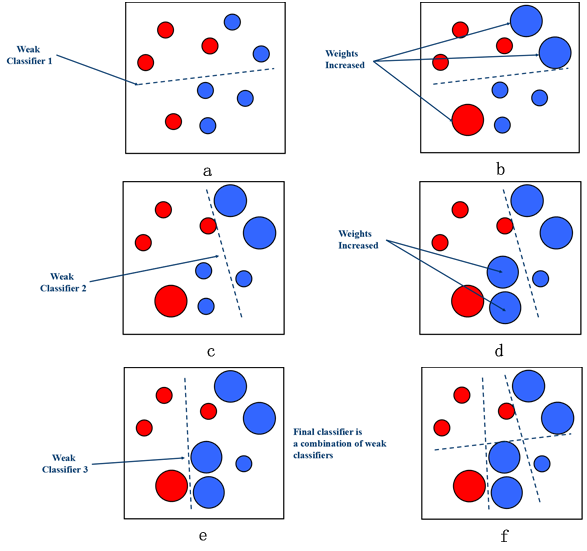Introduction
AdaBoost is an approach of Boosting, which is based on the principle that combining multiclassifiers can get a more accurate result in a complex environment.
AdaBoost Model
The AdaBoost model consists of weak classifiers, weight update and classify.
Weak Classifiers
AdaBoost combines weak classifiers with certain strategies to get a strong classifier, as shown below. At each iteration, the weights of samples which are wrongly classified will increase to catch the classifier "attention". For example, in Fig. (a), the dotted line is the classifier-plane and there are two blue samples and one red sample which are wrong classified. Then, in Fig. (b), the weights of two blue samples and one red sample are increased. After adjusting the weights at each iteration, we can combine all the weak classifiers to get the final strong classifier.

Weight Update
There are two types of weight to update at each iteration, namely, the weight of each sample  and the weight of each weak classifiers
and the weight of each weak classifiers  . At the beginning, there are initialized as follows:
. At the beginning, there are initialized as follows:


where N, M are the number of samples and the number of weak classifiers respectively.
AdaBoost trains a weak classifier at each iteration denoted as  whose training error is calculated as:
whose training error is calculated as:

Then, update the weight of weak classifier by:

Update the weights of samples by:

where:

From the above equations, we can conclude that:
- The training error is the sum of weights of the wrong classified samples.
- When em is less than 0.5, am is greater than 0, which means the lower training error the weak classifiers has, the more important role that weak classifier plays in the final classifier.
- The weight update can be written as:

which means that the weights of right classified samples decrease while the weights of wrong classified samples increase.
The code of training process of AdaBoost is shown below:
def train(self, train_data, train_label):
if self.norm_type == "Standardization":
train_data = preProcess.Standardization(train_data)
else:
train_data = preProcess.Normalization(train_data)
train_label = np.expand_dims(train_label, axis=1)
sample_num = len(train_data)
weak_classifier = []
w = np.ones([sample_num, 1])
w = w/sample_num
agg_predicts = np.zeros([sample_num, 1])
for i in range(self.iterations):
base_clf, error, base_prediction = self.baseClassifier(train_data, train_label, w)
alpha = self.updateAlpha(error)
weak_classifier.append((alpha, base_clf))
expon = np.multiply(-1 * alpha * train_label, base_prediction)
w = np.multiply(w, np.exp(expon))
w = w/w.sum()
agg_predicts += alpha*base_prediction
error_rate = np.multiply(np.sign(agg_predicts) != train_label,
np.ones([sample_num, 1]))
error_rate = error_rate.sum()/sample_num
if error_rate == 0:
break
self.classifier_set = weak_classifier
return weak_classifier
Classify
Combine all the weak classifiers to get a strong classifier. The classify rule is the weighted sum of each weak classifier result, which is given by:

Conclusion and Analysis
AdaBoost can be regarded as additive model with exponent loss function using forward forward step algorithm. In AdaBoost, the type of weak classifiers can be different or the same. In this article, we use 5 SVM classifiers as the weak classifiers, and the detection performance is shown below:

It can be that the accuracy increases about 5% and the runtime is about 5 times of the single SVM.
The related code and dataset in this article can be found in MachineLearning.
Ryuk is interested in Machine Learning/Signal Processing/VoIP.




